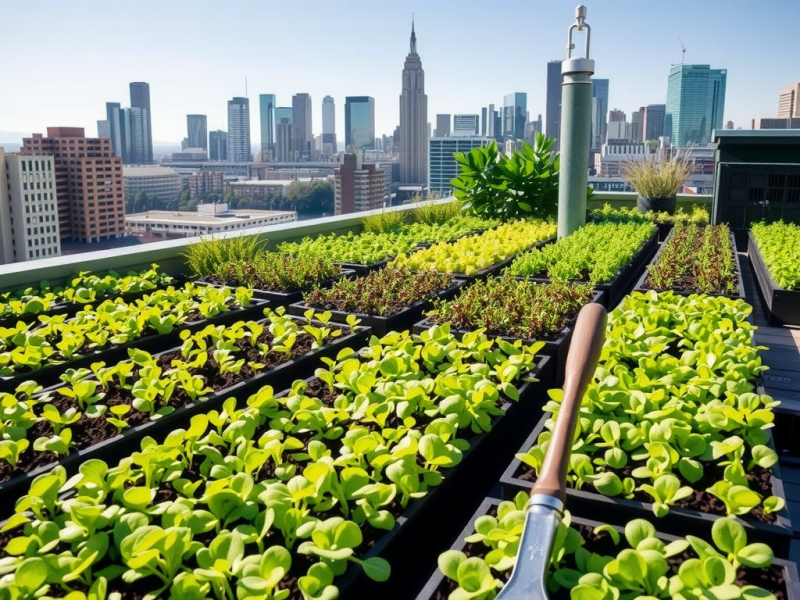
Microgreens are far more than a culinary trend—these vibrant, nutrient-rich plants are transforming our relationship with food. With a growing focus on health-conscious eating, the popularity of these tiny greens is rising rapidly.
Their dazzling colors and bold flavors make them ideal for enhancing salads, dishes, and culinary garnishes.
Today’s market reflects a surge in consumer interest in functional foods, driving significant growth.
A keen focus on sustainability has brought innovative growing methods like vertical farming and hydroponics into the spotlight.
These practices optimize resources such as water and space, positioning microgreens as a go-to choice for eco-conscious eaters. As more consumers lean towards fresh, local produce, the microgreens market is poised for even greater expansion.
Click here to learn more about: microgreens business plan template
Emerging Trends In Vertical Farming
Vertical farming stands at the forefront of revolutionizing food production in urban areas, perfectly complementing the microgreens market.
Projections indicate that this sector will surpass $12 billion by 2026, driven by increasing urban populations and a demand for sustainable solutions. For instance, LED lighting enhances crop yields, ensuring microgreens grow efficiently within controlled environments.
- Urban Agriculture Growth: This trend boosts access to fresh produce in limited spaces.
- Technological Innovations: Advances like automation technology and aeroponics improve agricultural efficiency.
- Health Benefits: Microgreens are packed with nutrients, making them perfect for nutrient-rich diets.
As urban farming initiatives gain momentum, the connection between vertical farming and microgreens becomes increasingly clear. These nutrient-rich crops thrive in compact spaces, bringing fresh, flavorful greens to city residents. This trend not only satisfies consumer demand but also promotes environmental sustainability, steering us toward a greener future.

How Hydroponics Influences Microgreens
Hydroponics is revolutionizing sustainable agriculture by providing an innovative farming method that enables farmers to cultivate microgreens in controlled environments without soil. This approach significantly reduces water usage and space requirements, making it an eco-friendly option.
When these microgreens are grown using hydroponics, they enjoy enhanced nutrient absorption, resulting in some impressive benefits.
For example, you’ll often find hydroponically grown microgreens packed with Vitamin C, which is essential for boosting immune health.
A fantastic example of a thriving hydroponic microgreens business is AeroFarms. Utilizing advanced vertical farming technology, they not only excel in the market but also promote positive eco-friendly practices, making informed choices accessible to consumers.
Benefits Of Nutrient-Rich Diets
Embracing nutrient-rich diets is becoming crucial as more people focus on their overall wellness.
Microgreens are a fantastic choice in this journey, often highlighted for their dense nutrient profiles. Research indicates that these edible greens typically pack more nutrition than their mature counterparts.
Studies reveal that they contain elevated levels of antioxidants, which can significantly aid in disease prevention.
Incorporating microgreens into your meals is simple and rewarding.
- Add them to smoothies for a nutritious boost.
- Top your salads with vibrant microgreens to enhance flavor.
- Use them as garnishes for culinary dishes to elevate presentation.
Not only do these vibrant greens enrich your meals, but they also make eating healthy an enjoyable part of your daily routine. Incorporating nutrient-dense microgreens can seamlessly align with health-focused diets, promoting a more balanced lifestyle.
- Hydroponically grown microgreens can contain up to 40 times more nutrients than their mature counterparts.
- Microgreens are known to have high levels of antioxidants, which can help reduce the risk of chronic diseases.
- The use of hydroponics can reduce water usage by up to 90% compared to traditional soil farming.
- Incorporating microgreens into meals can enhance flavor and visual appeal, making healthy eating more enjoyable.
Exploring Edible Greens Market Growth
Have you noticed how the edible greens market is really taking off? This boom is largely driven by a surge in consumer interest in healthy eating practices. Recent market analysis shows that the edible greens sector is on track for impressive expansion, with predictions highlighting the impact of health-conscious eating trends.
For example, the brand Green Sprout has caught the market’s eye by offering unique blends of nutrient-rich greens, showcasing culinary innovation while catering to consumer demands.
As more individuals prioritize wellness, edible greens not only attract health-focused diets but also enhance meal kit integration, making them a must-have in modern kitchens.
The rise in demand for fresh, nutrient-dense ingredients illustrates a shift towards more conscious eating habits.
With the integration of home gardening kits and urban agriculture, consumers are eager to add these fresh ingredients to their plates.
The convenience of meal kits that feature edible greens enhances their appeal further, illustrating a seamless blend of health and flavor. This growth avenue hints at a vibrant future for edible greens, tapping into diverse market segments and supporting the farm-to-table movement.
Sustainable Agriculture And Microgreen Demand
Microgreens shine bright as champions within sustainable agriculture.
These tiny, nutrient-packed plants fit perfectly into the broader context of sustainability, appealing to consumers leaning towards eco-friendly products. Utilizing methods such as vertical farming and hydroponics, these greens require minimal space and resources, making them an excellent choice for urban environments.
Fresh Greens Farm is a fantastic example of how local farming can embrace sustainability while meeting consumer demand.
This local farm successfully grows a variety of microgreens while sticking to sustainable practices.
Their model showcases how adapting to consumer health trends not only fulfills immediate demand but also promotes environmental consciousness.
As eco-conscious consumers increasingly seek out fresh produce, microgreens play a significant role in bridging culinary innovation with sustainability.
The growing trend of urban and indoor cultivation means microgreens are attainable for many, which enhances their popularity across various culinary applications.
With the market’s projected growth, it’s clear that microgreens will remain a vital player in both the gardening and food sectors. They offer everything from vibrant flavors to enhanced nutrient profiles, appealing to health-focused diets, while also supporting sustainable practices that resonate with today’s environmentally aware consumers.
Edible Greens and Microgreens
- The edible greens market is experiencing significant growth due to rising consumer interest in health-conscious eating.
- Brands like Green Sprout are innovating with unique blends of nutrient-rich greens to meet consumer demands.
- Microgreens thrive in urban settings due to their minimal space and resource requirements, making them ideal for sustainable agriculture.
- Fresh Greens Farm exemplifies how local farms can adapt to health trends while promoting sustainability through eco-friendly practices.
Home Gardening Kits In Urban Areas
Embracing urban gardening has become a delightful trend for many city dwellers eager to reconnect with the joy of self-sufficiency. This movement encourages sustainable practices while allowing individuals to grow their own food, right from their homes.
Among various options, microgreens stand out as the perfect choice for those with limited spaces.
They flourish on windowsills and balconies, making them ideal for any urban setting.
When it comes to choosing a home gardening kit, it’s essential to reflect on your space.
Whether you’re interested in a starter kit that comes with seeds, soil, and containers, or you’re leaning towards eco-friendly options, the right selection can fundamentally impact your gardening experience. Get ready to dive into urban agriculture and learn just how easy it is to cultivate a variety of vibrant edible greens!
Meal Kit Integration With Microgreens
The popularity of meal kits continues to skyrocket as more people turn towards health-conscious eating habits.
By tapping into the unique flavors and vibrant colors of microgreens, these meal kits not only enhance culinary experiences but also align with the rising demand for functional foods.
Elevating Your Dishes
One fantastic way to feature microgreens prominently is through a delightful dish like Microgreen Salad with Lemon Vinaigrette. Simply combine mixed microgreens, cherry tomatoes, and cucumber, then finish it off with a drizzle of lemon juice and olive oil for a quick, refreshing meal.
Discover just how meal kit integration can ignite your cooking with fresh ingredients while supporting your journey to health-focused eating!
Microgreens are not just a garnish; they’re a way to pack nutrients into your everyday meals, helping elevate your health-conscious diet!
Home Gardening and Microgreens
- Urban gardening can significantly reduce food miles, contributing to lower carbon emissions.
- Microgreens are packed with nutrients, often containing higher vitamin levels than their mature counterparts.
- Meal kits featuring microgreens can enhance flavor and presentation, making healthy eating more appealing.
- Growing your own microgreens can save money on groceries while providing fresh produce year-round.
Innovations In Indoor Farming Techniques
Exciting advancements are transforming indoor farming with innovative techniques that seamlessly merge technology and agriculture. Vertical farming systems, for example, not only maximize space but also enhance resource efficiency, enabling urban dwellers to cultivate food right at home.
This method employs hydroponics, which can boost yields by up to 30% compared to traditional farming, while using significantly less water and reducing the environmental footprint.
The Role of Automation Technology
With the rise of automation technology and IoT devices, farmers now monitor crop conditions in real-time.
This ensures controlled environments that promote growth and sustainability.
By integrating advanced systems, urban agriculture can thrive, allowing fresh produce to flourish right where people live.
Impact on Food Security and Community Connection
As urban areas face increasing population densities, these innovations are crucial for enhancing food security. Growing fresh produce locally lessens transportation needs and fosters a stronger connection between communities and their food sources.
This shift paves the way for healthier, more nutrient-rich diets accessible to everyone in the city.
Microgreens: A Nutritional Powerhouse
Among the most interesting innovations are microgreens, young plants harvested early in their growth stage. Not only do they add vibrant colors and intense flavors to dishes, but they also pack a punch in terms of nutrition.
With rising consumer interest in functional foods and health-focused diets, the demand for these nutrient-rich greens continues to grow.
Current Trends in the Microgreens Market
- Rising Consumer Demand: A growing focus on health and wellness drives interest in microgreens.
- Sustainability Focus: Techniques like vertical farming and hydroponics optimize resources such as space and water.
- Expanding Applications: Microgreens now find their way into cosmetics and personal care products, thanks to their high nutrient content.
- Technological Innovations: Methods like aeroponics and automation improve production efficiency.
- Market Diversification: New and exciting varieties, such as amaranth and shiso, are becoming popular.
- Integrated Food Systems: Microgreens are increasingly featured in meal kits, restaurant menus, and subscription services.
- E-commerce Growth: Direct-to-consumer sales enhance accessibility.
- Urban and Indoor Cultivation: More urban centers are adopting local farming initiatives to grow microgreens due to their fast growth cycles.
- Home Gardening Trend: DIY kits for growing microgreens are trending among health-conscious consumers.
Through these innovations in indoor farming techniques, we are witnessing a shift towards sustainable practices, enhanced health benefits, and vibrant culinary applications that not only enrich our meals but also connect us more closely to our food systems.
Indoor Farming Innovations
- Vertical farming can increase crop yields by up to 30% while using significantly less water compared to traditional farming methods.
- Automation technology allows for real-time monitoring of crop conditions, promoting optimal growth and sustainability in urban agriculture.
- Microgreens are not only nutrient-dense but also have seen a rise in consumer demand due to their health benefits and culinary versatility.
- Urban farming initiatives are becoming more popular, with many cities adopting local farming practices to address food security and community connections.



